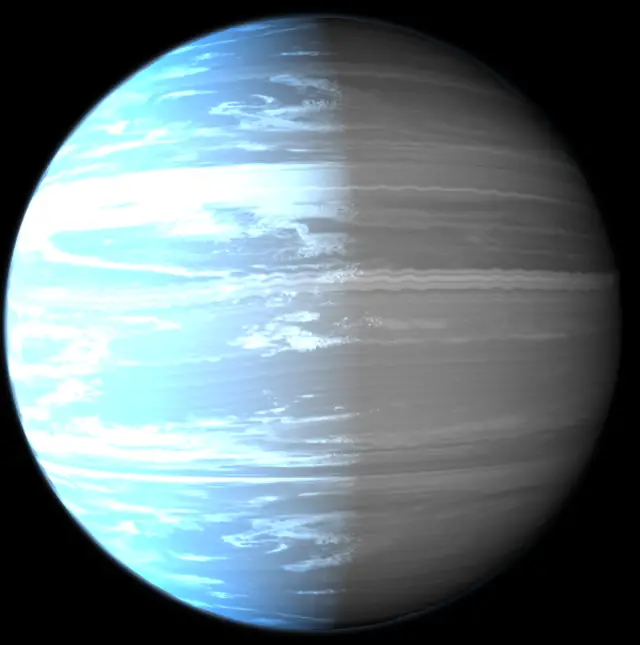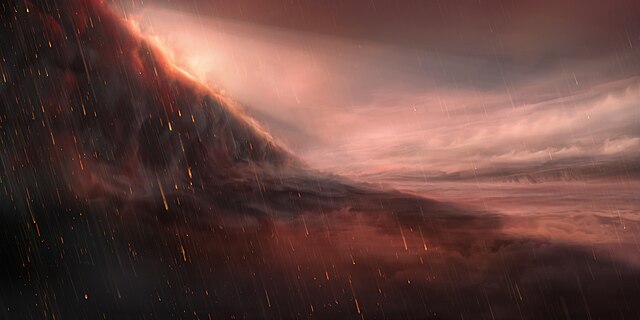A world where the rain isn’t water, but molten iron falling from the sky in searing, fiery torrents. The wind howls like a beast unleashed, carrying scorching metal vapor from one hemisphere to another at thousands of miles per hour. As night falls, the superheated iron condenses into a deadly metallic downpour, turning the landscape into a relentless storm of liquid fire. This isn’t science fiction—it’s the horrifying reality of WASP-76b, one of the most extreme exoplanets ever discovered, where the very concept of weather defies imagination.
What Is WASP-76b?
WASP-76b is a gas giant exoplanet, orbiting a star about 640 light-years away in the constellation Pisces. It belongs to a class of planets known as ultra-hot Jupiters, but calling it “hot” is an understatement. The planet is so close to its star that it completes an orbit in just 1.8 Earth days, experiencing temperatures exceeding 4,350°F (2,400°C)—hot enough to vaporize iron.
Like our Moon to Earth, WASP-76b is tidally locked, meaning the same side always faces its star. This creates a stark contrast: the day side is an inferno where iron turns to vapor, while the night side is just cool enough for the vaporized metal to condense and fall as molten iron rain.

The Science Behind the Iron Rain
Scientists first detected WASP-76b’s bizarre weather in 2020, using the European Southern Observatory’s Very Large Telescope (VLT). They found strong evidence of iron vapor in the planet’s atmosphere, but only on the side facing the star. As powerful winds whip the vapor around to the night side, it cools and condenses into blazing-hot raindrops of liquid metal—a phenomenon never before observed on any other planet.
This discovery has huge implications for our understanding of extreme planetary weather. It proves that exoplanets can have completely alien climates, where even something as common as rain transforms into a nightmarish, fiery spectacle.
How WASP-76b Defies Expectations
WASP-76b doesn’t just have extreme weather—it also challenges what we thought we knew about gas giants. Typically, Jupiter-like planets have uniform cloud layers, but WASP-76b’s intense heat breaks molecules apart, preventing normal cloud formation. Instead, the planet’s atmosphere is a chaotic mix of ionized metals and powerful winds moving at speeds of over 10,000 mph (16,000 km/h).
Additionally, the planet’s dayside glows white-hot, emitting as much energy per square foot as some stars. Its ability to radiate heat so effectively gives scientists insight into how planets behave under extreme conditions, helping refine models for understanding gas giants both in and outside our solar system.
Could Anything Survive There?
Absolutely not. WASP-76b is the definition of an inhospitable world. The searing temperatures alone would destroy any known life form instantly. Even robotic probes wouldn’t last—metal would melt within seconds, and no material we have could withstand the iron rain and hurricane-force winds.
But studying planets like WASP-76b is crucial for understanding the diversity of worlds beyond our solar system. It proves that the universe is home to environments more extreme than we ever imagined, pushing the boundaries of what we consider possible.
What WASP-76b Teaches Us About the Cosmos
Discoveries like WASP-76b help scientists refine our search for habitable worlds. While this exoplanet is clearly unlivable, it provides insight into how atmospheres behave in extreme conditions, helping researchers identify planets with more stable, life-supporting climates.
Moreover, studying ultra-hot Jupiters like WASP-76b can tell us about planetary formation, migration, and atmospheric chemistry. These massive gas giants aren’t just curiosities—they could hold the key to understanding how planets evolve over billions of years.
A Universe of the Unexpected
WASP-76b is a reminder that the universe is full of surprises. While Earth experiences gentle rains and cool breezes, there are planets out there where molten metal falls from the sky and winds rage at incomprehensible speeds. It’s a testament to the vast, wild diversity of worlds beyond our solar system—a universe far stranger than fiction, waiting to be explored.

